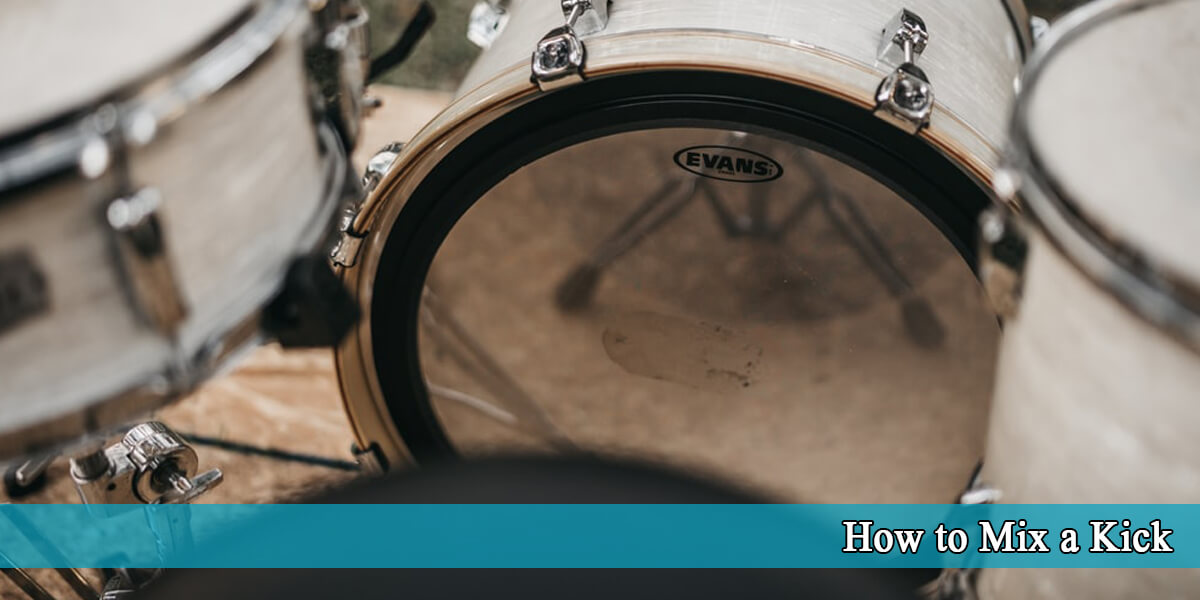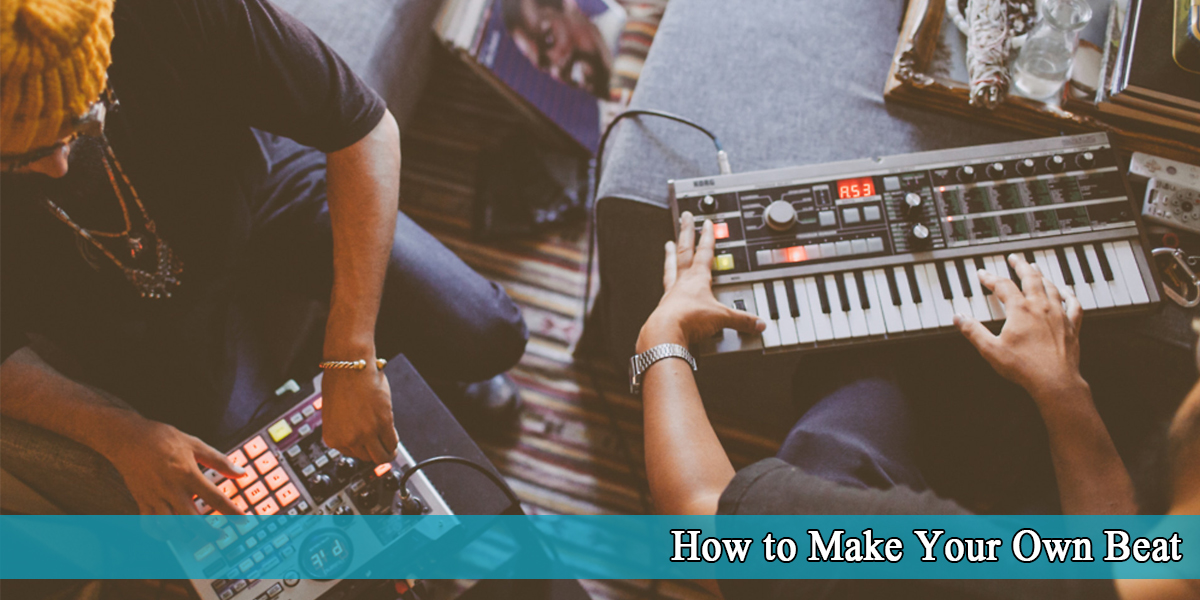How to Mix Bass
Introduction
No matter how it’s played, mixing bass guitar is one of the most important parts of your music. But it’s also one of the toughest to get right. Want your tracks to sound professional? Check out this guide to learn everything you need to know to mix a killer bass.
Of course, this doesn’t include the kick drum. That’s the bass’s older brother. They fight and get on each other’s nerves, but at the end of the day, they’re still family.
Compressing bass
In most types of music, we usually want a consistent, stable low end. If you have both an amp and a DI, it’s common practice to compress the DI signal heavily after blending the two. Because the DI is so clear, it can usually handle aggressive compression very well.
By compressing the DI and leaving the amp signal more dynamic, you get the best of both worlds—a solid, steady low end with dynamic articulation.
If you don’t have both signals, try using a multiband compressor to control everything below 150 Hz. Set medium attack and release times, and use compression to lock in the low end.
Aim for medium gain reduction, with attack and release times that fit the feel of the line. Most of the time, you’re looking for balance, so start with medium settings for compression, attack, and release. A ratio of 4:1 to 6:1 works well, and don’t forget to compensate for any gain reduction.
Make sure to adjust the gain compensation to match the input and output volumes. This is a crucial step to keep your bass track even and consistent.

Utilizing a limiter when mixing bass
It might seem counterproductive, but adding a limiter to your bass can actually help it cut through the mix much better and bring out some of the upper bass frequencies. These upper frequencies often get lost during production, especially when a low-pass filter is used.
Start by adding a limiter to your bass—just use the built-in one in your DAW if you like. Set the ceiling to -1dB to begin, and apply no more than 6dB of gain reduction with your limiter. In this case, less is more.
This technique will give your bass its energy back and help it stand out in the mix without losing those important higher bass frequencies. Not only will your bass sound louder and punchier, but all the bass frequencies will also be more balanced.
Depending on the type of bass you’re using, you can also try using a compressor or soft-clipping instead. A limiter works best on sub-bass or digital bass, while a compressor is better suited for acoustic bass.
Soft-clipping can level out the main frequency of your bass and give it extra energy, similar to a limiter. However, it will also add its own color and distortion, so experiment and see what works best for your track.
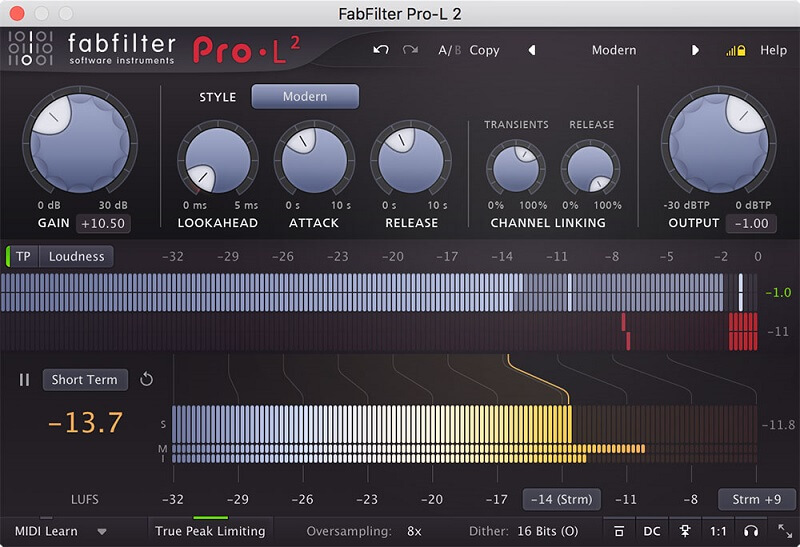
EQing Bass
Spectral slotting uses EQ to carve out space in the frequency spectrum for each track to sit comfortably. Think of it like my dresser analogy—it’s as if you’re moving a track from one drawer to another, giving everything its own place.
Here’s how you can do it:
First, listen to the bass and kick drum together. Ask yourself—which one is more important? Which one carries the groove or anchors the song?
Add an EQ to the less important track.
Now, sweep a hefty boost up the frequency spectrum while listening to both tracks together. Find a spot where the other track becomes hard to hear. That’s the frequency you want to cut.
Slowly dip out that frequency while listening to the other track. Stop when both tracks sound clear.
There are some general guidelines you can follow, but in the end, you’ll need to trust your ears!
Here are some frequency areas you might consider boosting or cutting:
- 60Hz – 200Hz: This is where most of the bass guitar’s power comes from. Be careful not to boost too much here, or you might end up with distortion during mastering.
- 200Hz – 500Hz: This range is where your bass can start to sound “muddy.” Cutting frequencies here can give you that “scooped” sound, which is much clearer.
- 500Hz – 1kHz: In this range, the bass can sound “nasally.” Boosting here gives a “honky,” more metallic tone.
- 1kHz – 5kHz: This is where the pick attack lives (if you’re using a pick). Adjusting this range can make your bass sound tighter or looser.
Finally, try not to boost or cut more than 5dB. Making too many big changes with EQ can cause phase issues and make your bass sound unnatural.
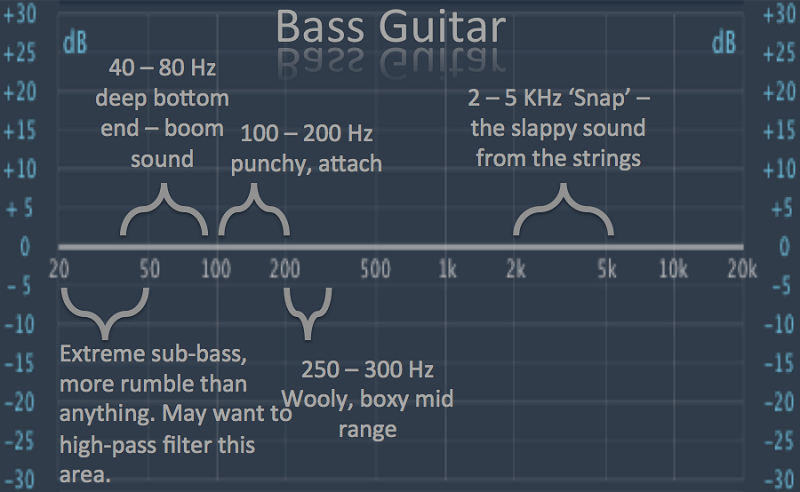
EQ Treatment for Mid Bass Area
If you keep boosting the low end too much, you’ll end up with a mix that sounds really muddy and boomy.
To make your bass stand out, especially on audio systems with a limited frequency range, focus your energy higher up in the frequency spectrum.
Instead of boosting around 100 Hz, try looking closer to the 200 Hz area for a solid low-end and mid-range weight.
Even so, too much in this range can quickly get muddy. Adding just a few dBs around 600–800 Hz will bring out the harmonic overtones of the fundamental note (whatever that note is, depending on the key of your song and the bassist’s playing style).
The mid frequencies, even up into the high-mids, are where you’ll get the attack of the bass. If you want to hear more of the sound of the bass strings, explore even higher up the frequency spectrum.
EQ Pocket for the Bass
One of the simplest ways to make your bass guitar stand out is to clear out the lower frequencies from other instruments. If you want the bass to be more prominent, use EQ to lighten up the low end on the piano, low-end synths, and guitars.
Things can get a bit trickier when you need other elements to occupy the low end too. If you want guitars, vocals, or synths to sound powerful, you’ll need to compromise a little. In this situation, try leaving some space in the low-mid frequencies for the bass guitar.
Consider reducing the 700Hz–1.5kHz range on the other instruments and giving that same area a slight boost on the bass. The bass might not be the main focus of the low end, but it will have its own space where it isn’t masked.
The overtones of the bass guitar usually sit in the low-mid range, along with the main tones of the guitars.
We’re usually cutting this frequency range from kick drums and toms, getting their punch from the upper midrange instead. Four-string bass guitars don’t naturally have a lot of sub-frequencies, but kicks do have a naturally occurring sub-bass tone.
Bass Headroom
Sub-bass power eats up headroom, but you also need headroom to make a mix sound loud. Ironically, the genres that demand powerful, exaggerated bass are often the same ones that need to seem the loudest. This is a challenge even for experienced mixing and mastering engineers.
As a general rule, the louder a track’s subfrequencies are, the less limiting you can apply before distortion sets in. So, if you want a massive bottom end, you’ll probably have to sacrifice a few dB of gain reduction on your master maximizer. On the other hand, if maximum loudness is your goal, you may need to pull back the sub frequencies so you can push the limiter harder.
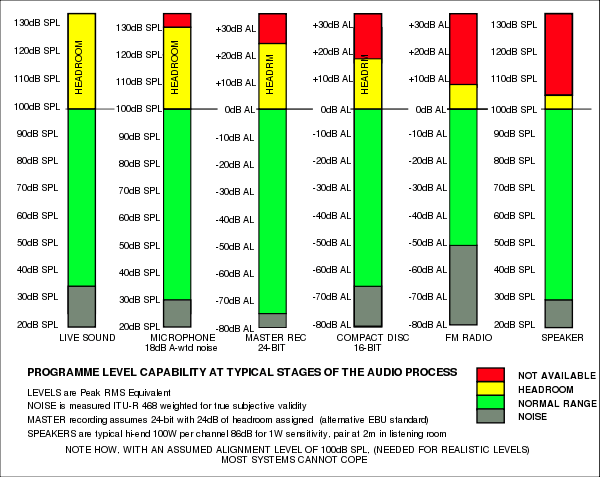
Fade out/in end/beginnings of the bass
When synthesizing sub-bass, those annoying clicks at the start and end—caused by non-zero crossings—can be a real problem. Increasing the amp envelope’s attack and release times can help reduce these pops, but it may also take away some of the initial impact.
One of the best, though most time-consuming, solutions is to bounce your sub part to audio, then trim and fade the edges to remove clicks. While not an exact process, it’s an important step in mixing bass guitar. Cleaning up those pops and clicks will clarify the frequency spectrum, leaving you with only the sound you need.
Bass and Kick Mixing
Bass and kick drums work together to create the musical foundation that allows the lead instruments to be melodic, harmonic, and even rhythmic. Because of this, we should pay special attention to these instruments.
They need to have enough volume and punch without overlapping or interfering with different frequency ranges. Volume is especially important since we want to feel the low end as much as we hear it.
Fortunately, the fundamental range isn’t the only thing that shapes the sound of each instrument. The kick drum has both an attack and decay, while the bass produces a rich set of overtones that help us tell which notes are being played.
Panning Bass
The goal for all mix engineers is to ensure that the bass and kick drum can coexist clearly in the low end. The bass’s overtones shouldn’t clash with the kick drum’s attack, and both the overtones and the attack should avoid interfering with the higher-frequency instruments.
This challenge becomes even trickier when we remember that we shouldn’t pan either the bass or the kick drum. Both should sit right in the center so that each speaker shares the load of delivering the thump and keeps the listener anchored in the stereo field.
You can have a lot of fun experimenting with the stereo placement of many tracks in a song, but the bass usually isn’t one of them. The power of low-end frequencies is seriously weakened as soon as they move away from the center of the stereo image.
That doesn’t mean bass tracks have to be strictly mono (though many are), but they shouldn’t be panned unless you have a really good reason for doing so.
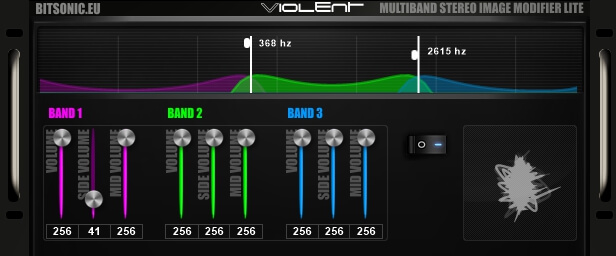
Layer Your Bass With A Sine Wave
Just like with any other sound, you can layer your bass to make it smoother, fuller, and stronger in your mix. Adding sub-bass will always help your bassline sound fuller.
A good choice for smooth, low-frequency sub-bass is a sine wave. To do this, add a sine wave that plays the same notes as your main bass, ideally in the 20-80Hz range. Apply a high-pass filter to your primary bass at around 80-100Hz to make space for the sine wave. You can raise the high-pass filter on the main bass even more if needed, but this is a good starting point. In this case, the high-pass filter is your friend, so make good use of it.
If adding a sine wave feels too complicated, there’s an easier way to layer your bass. Simply duplicate your main bassline and pitch it down an octave.
The most common waveform for sub-bass is a sine wave, but you can also try using square, sawtooth, or triangle waves to give your bass some extra character.
Some Extra Bass Mixing Tips
Pitch Correcting
While it’s tempting to jump straight into the more exciting parts of mixing, making sure your bass guitar is perfectly tuned is actually one of the most important steps—arguably even more important than tuning any other instrument.
Tuning the bass should always come first. If the bass is even slightly out of tune with the rest of the tracks, it can really throw off the overall feel of the song. This is especially true because the bass produces such strong, fundamental frequencies.
One big advantage of treating the bass guitar as a monophonic instrument is that you can use auto-tuners on it in a subtle and effective way. Even a well-tuned bass guitar can be a few cents sharp or flat by the time it reaches the mix engineer. This is more common with bass than with regular guitars, mainly because the strings are so thick.
Pitch correction can easily fix those last few cents and lock the bass in tune during mixing. This might make the bass sound a bit more artificial if it’s front and center in the mix, but depending on your style, that might not be a problem—especially if you’re going for a modern or upfront bass sound.
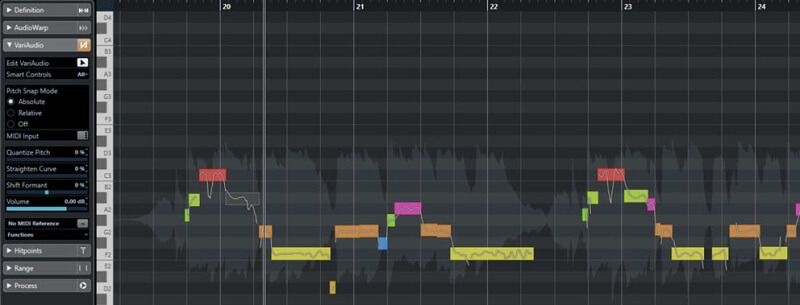
Saturation
Saturation and distortion are related in certain ways, as both can be used to boost the perceived loudness of your bass. The main difference lies in the effect that adding saturation has on your sound.
Adding saturation can bring more color to your mix, instead of simply hard-clipping the frequencies. Saturation effects are much gentler and can add a pleasant warmth to your mix.
Saturation is great for rounding out bass frequencies, helping them cut through the mix easily and smoothly, thanks to a gentle compression called soft-clipping. While distortion is heavy and gritty, saturation is warm and smooth.
Distortion
Distortion can help boost the perceived loudness of your bass and make it sound heavier or more intense. How much distortion you add depends on the kind of sound you’re aiming for.
Distortion is often used to get a more metal-inspired, aggressive tone, but it also works great in genres like dubstep and other styles with heavy bass elements.
Even though distortion technically means clipping frequencies, you can use it to your advantage by experimenting with different amounts. Try adding more or less distortion to see how it changes your sound. Don’t forget that parallel distortion can be really helpful here, so make sure to use it!

Enhance Room Acoustics and Monitoring
Having the right listening environment is essential when mixing bass. Poor quality monitors and untreated room acoustics can cause problems in the low frequencies. This often leads engineers to make poor decisions, resulting in mixes that don’t translate well to other systems.
Make sure your studio has a pair of full-range monitors. Smaller monitors may only reproduce frequencies down to around 40Hz–50Hz. While these can work for some mixing tasks, they aren’t accurate enough for mixing low-frequency content. You might consider adding a subwoofer to supplement smaller monitors and help reproduce those low frequencies.
Apply acoustic treatment to reduce room modes. Room modes are a series of resonances caused by a room’s natural acoustics. These typically occur between 20Hz and 200Hz, and they can create significant issues in this range. Use bass traps and absorptive acoustic panels to minimize the effects of room modes.
Frequently Asked Questions
How to make DI bass signal good
Recording bass guitar with a DI (Direct Input) gives you a clear signal to work with, but it often lacks the power and warmth you get from miking up a bass cabinet. To add more attack to your bass tone, try gently boosting the mid-range frequencies around 700-800Hz—this will give your sound extra bite and presence. If you want more string definition, boost around 2.5kHz.
For warmth and smoothness, you can run your signal through an amp emulator and subtly boost the gain around 80Hz.
How loud should the bass be within the mix?
When you mix your bass, you want it to be loud and punchy enough to stand out in the mix, but not so loud that it overpowers your kick drum.
How do you get a funky bass tone?
A great way to get a funky sound from your bass guitar is by using an envelope filter. This type of pedal is similar to a wah pedal, but it reacts to how hard you play. Play around with the knobs until you find the sound you’re looking for.
How do I make the bass be fuller?
You can make your bass sound fuller by layering your bassline. To do this, duplicate your bass track and lower the duplicate by an octave to add more depth, or simply add a sine wave playing the same notes as your main bassline.
You can also use a stereo effect to widen your bass. Duplicate your bass track, then apply a high-pass filter to the duplicate. This lets you widen the higher frequencies without affecting the low end of your bassline, which helps you avoid phase issues.
How do I make my bass sit in a mix?
To help your bass sit nicely in the mix, make sure there aren’t any other instruments or frequencies in the same range competing with it. This can cause muddiness and make your bass disappear in the mix.
You can also help your bass cut through better by adding some distortion or saturation. Another option is to increase the bass volume by using a limiter, or by applying a high-pass filter to remove inaudible low frequencies, allowing you to turn the volume up without problems.
How can I make my sub-bass sound better?
Using a sine wave for your sub-bass is usually very effective—just make sure you place it in the right octave so it matches your main bass better.
To make your sub-bass sound better on any speaker, try adding more harmonics. You can do this by experimenting with different waveforms, like a triangle wave, and trying it in a higher octave.
Conclusion
At the end of the day, mixing bass and kick drums—like most things in music production—is all about deciding what you want and then figuring out how to get there. The real magic comes from making the right choices along the way.
Spend plenty of time experimenting with different bass samples and lines, and keep practicing! This is the best way to keep improving your skills. If you take good care of your low end, you’ll build a solid foundation for your track. Once that’s sorted, the rest of the song should come together much more easily.
Hopefully, this article has given you some useful ideas and strategies to help you get there.

